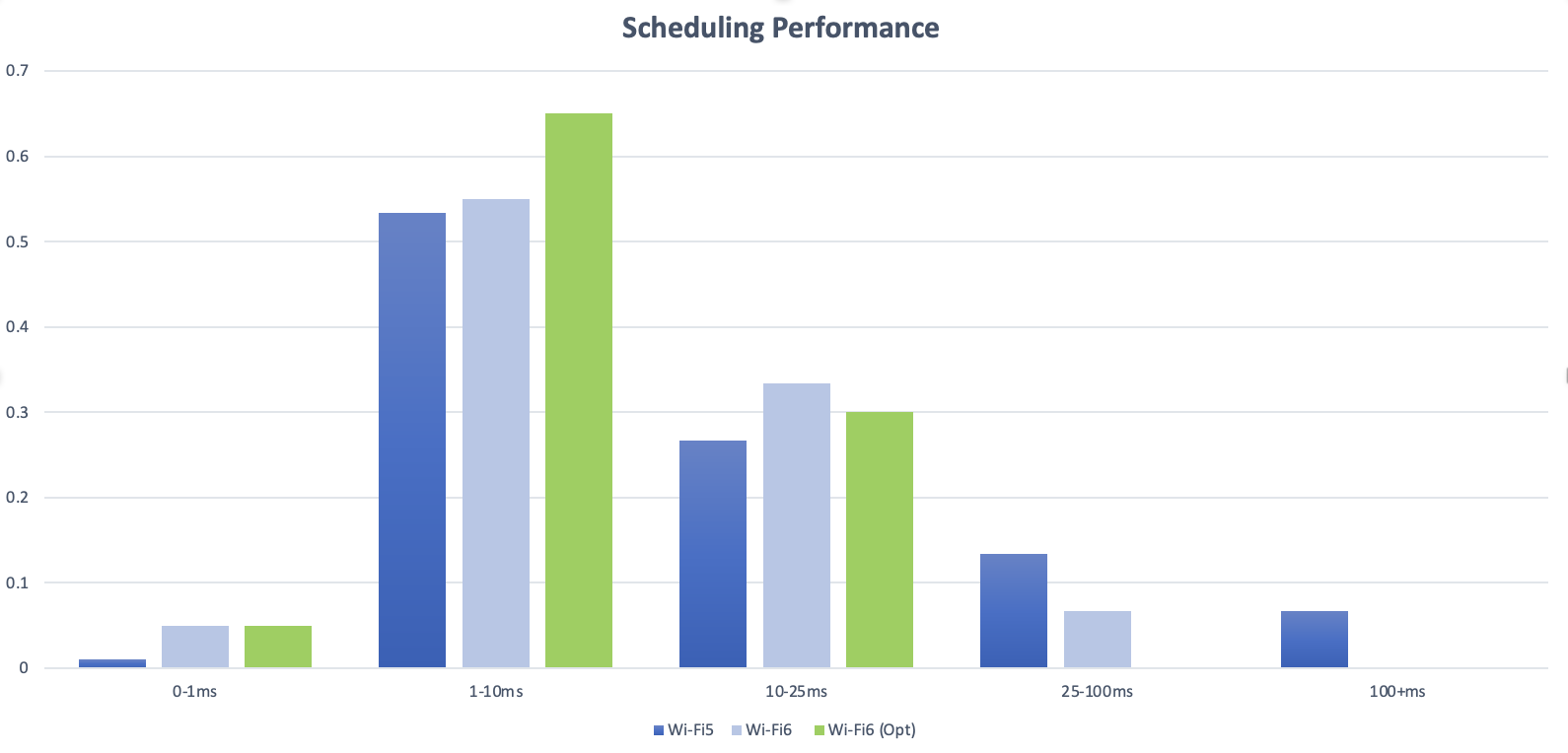Half 1 of the 4-part Wi-Fi 6E Collection
That is half 1 of a 4-part sequence entitled “One thing previous, one thing new, one thing borrowed and one thing blue”. Every of those 4 blogs will dive into completely different points of the newest Wi-Fi 6E normal, new improvements, and why it’s necessary to grasp these options.
With the current launch of plenty of Wi-Fi 6E-enabled gadgets on the Shopper Electronics Present (CES), now is an efficient time to bear in mind among the advantages that Wi-Fi 6/6E gives. Wi-Fi 6/6E was not an “incremental” change, it was a serious leap ahead with the brand new improvements and most significantly, the addition of the newly allotted 6GHz spectrum (which varies throughout areas). On this sequence, we’ll present the reader with an in-depth understanding of a few of these superior options in Wi-Fi 6 and the way a few of these options profit them. Moreover, we’ll talk about among the new improvements constructed across the Wi-Fi 6E normal and the way IT leaders simply beginning to notice the potential for 6GHz wi-fi.
“One thing Outdated”
Whereas the power to help a number of simultaneous customers has been obtainable previous to Wi-Fi 6E that is one “previous” function that turns into enhanced in Wi-Fi 6E. Partially 1 we wish to take a look at among the modifications to the bodily layer, what modified, and the way this helps your WiFi efficiency.
Of all of the options added to Wi-Fi 6, one, specifically, could have a really important impact on the brand new 6GHz band and deserves some in-depth consideration and that’s OFDMA. Bear in mind all that previous 802.11ax optionally available functionality is now necessary at 6GHz as there is no such thing as a requirement for brownfield help. There have been different applied sciences added to the legacy bands in Wi-Fi 6 that actually paved the way in which for substantial enhancements in efficiency. For instance, elevated modulation charges (as much as 1024 QAM, consider this as increased most throughput), higher spatial isolation (BSSID Coloring/OBSS and a number of timers for IBSS and OBSS, consider this as higher efficiency in an space with a number of purchasers and APs), Goal Wait Time (higher battery life for purchasers), and others.
Digging into OFDM – The Digital Wires of Wi-Fi
OFDM is the “baseband” sign which is the underlying waveform that’s used to generate the RF sign we consider as Wi-Fi from the digital enter. This baseband sign is comprised of a number of “tones”. The mix of those tones known as Orthogonal Frequency Division Multiplexing (OFDM). Every tone is orthogonal to the opposite tones which implies the data on that tone could be detected with restricted interference from different tones regardless that they’re tightly spaced collectively. Consider every of those tones as a wire that info could be carried out. Fewer tones imply fewer wires however increased throughput for anyone wire, extra tones imply extra wires however decrease throughput per wire. The whole “obtainable” throughput, in both case, finally ends up being mainly the identical. In 802.11ax a change was made to maneuver from 64 tones to 256 tones (4x) in a 20MHz channel.

As mentioned, this improve in tones has little or no influence on the hyperlink obtainable throughput however, there are different trade-offs. First, the 4x improve in tones improves the robustness of multipath (improved resistance to inter-symbol interference) however loses some effectiveness in a high-speed cell setting (doppler shift). So, beneath typical indoor use, we get a advantage of a extra dependable connection. The second, and largest change is the power to higher “sub-channelize” the bodily layer. This entry technique known as Orthogonal Frequency Division A number of Entry or OFDMA. A sub-channel or group of tones at a given time slot is taken into account a “useful resource unit” sometimes called an “RU”.
For the reason that ratio of the variety of tones is relative to the bandwidth, in a 20MHz channel there could be as much as 9 RUs (26 tone teams) for anyone body and in a 160MHz channel this might go as much as 74 RUs (discover this isn’t 72 as there are some efficiencies as a consequence of increased ratio of usable tones at increased bandwidths). RUs can are available in bigger sizes additionally to match the useful resource demand. For instance, with a 20Hz channel, you may moreover have 52 tones, 106 tones, or the complete band on 242 tones. Moreover, you may to a point combine and match these different-sized RUs in the identical body. These RUs present a mechanism to transmit to multi-users (MU) on the identical time with out having to depend on spatial range. Let’s put a quantity to why that is necessary. Take a 64-byte packet working at some typical fee like 256 QAM with ¾ fee coding (MCS8). With 40MHz channels, one slot is able to round 380 bytes. What occurs if a 64-byte packet (typical packet) is transmitted over this 40MHz channel? Lower than 20% of the channel is used, and over 80% of that useful resource is wasted! With using RU’s, we will ship a number of packets on the identical time and just about eradicate that inefficiency. Granted not all packets are 64 bytes however bigger packets are damaged into smaller bodily layer packets referred to as Protocol Information Items (PDUs) to be transmitted and once more won’t replenish the complete spectrum for all PDUs.
So how does the AP sign the consumer when and the place its RUs are allotted since there are actually a number of consumer packets in a time slot? That is achieved utilizing two mechanisms. First, there’s now a brand new subject within the preamble that gives the “the place” referred to as SIG-B. This subject gives how the useful resource items are allotted over the slot and the per-client info that specifies which useful resource items are allotted for my particular consumer.
There are actually 3 choices to transmit multi-user packets on the identical time:
- A number of simultaneous customers’ alerts are transmitted utilizing the complete band however the spatial traits of the channel enable them to speak with restricted interference (spatial separation).
- Multi-Person with completely different customers assigned to completely different RUs (frequency separation).
- A mixture of each.
Choice 1 is a multiplier – If the channel permits sending a number of streams over the identical channel the capability of the channel grows proportional to the variety of customers. There are limitations to this, for instance, the variety of uplink spatial streams is the same as or lower than the variety of uplink receivers within the entry level. If the AP and the setting help possibility 1 it will sometimes be used.
Choice 2 is an optimization – If the community has a number of purchasers that help Wi-Fi 6 which have visitors to ship on the identical time the community will optimize by sending the visitors on the identical time.
The second operate that facilitates the “when” using a number of purchasers is the “set off body”. When the AP is prepared for the purchasers to concurrently ship uplink info it transmits a set off body with the consumer info. The consumer waits for one quick interframe spacing (SIF) after which transmits the uplink information on the suitable RUs. The AP can then ship again a “multi-Station ACK” permitting the a number of consumer uplink packets to be acknowledged concurrently. Uplink ACKs are transmitted equally to the uplink information with a set off body on the allotted RUs.

Given 6GHz has a a lot bigger block of spectrum and the most typical FCC regulation to deploy is predicated on energy spectral density (PSD), which permits for extra energy with wider channels, it’s anticipated that the majority deployments will use 80MHz or 160MHz (see 6-GHz Unlicensed Spectrum Rules and Deployment Choices White Paper). With the earlier technology of 1 packet per time, slot 80MHz channels grew to become very inefficient, and therefore why you not often noticed one of these operation for a number of entry. With 802.11ax the power to do each frequency and spatial division, the purchasers could be assigned solely the sources mandatory for his or her wants irrespective of how large the channel is thus making using these wider channels rather more efficient. Within the 2.4GHz and 5GHz bands purchasers able to supporting OFDMA needed to contend for a slot with legacy purchasers and naturally because it requires multiple consumer to take part in “a number of entry” it will solely contend for a multiuser slot if there have been a number of purchasers that might help OFDMA with packets to switch. At 6GHz all purchasers help OFDMA and therefore no have to deal with legacy purchasers for entry, each slot can transmit a number of packets. With the addition of the 6GHz channels, we’ll simply now start to totally profit from using OFDMA.
With Wi-Fi 6 the hyperlink can now be divided into each bandwidth and time so particular chunks of sources could be “scheduled” for supply additional bettering effectivity and latency (see Determine 2 beneath).
Along with the advance of effectivity within the wider band channels the “triggered multi-user entry” permits for the scheduling of packets in a way more predictable method. The 802.11ax normal doesn’t dictate all the required particulars for managing the packet scheduling and therefore that is an space the place there could be some differentiation in efficiency between implementations. Cisco, an organization with a wealthy historical past of packet scheduling and optimization is clearly exploring this space additionally. For instance, within the information beneath we will see the latency comparability between a typical Wi-Fi 5 community, a Wi-Fi 6 community, and a Wi-Fi 6 community with optimization in scheduling. Discover with Wi-Fi 6 there’s a substantial discount in outlying packets exceeding the 25ms delay sure and with some optimization, an additional discount in latency could be seen. That is an instance of the worth of optimized scheduling with 802.11ax multi-user functionality gives.

Wi-Fi 6E supplied a leap ahead in functionality. Some we couldn’t absolutely acknowledge till 6GHz was made obtainable. Advantages in capability, latency, and stability are all part of the 802.11ax replace. As well as, distributors like Cisco can present optimized packet scheduling to additional improve the person’s expertise. Deploying Wi-Fi 6E succesful entry factors will enable the operator to start to expertise these important new enhancements in efficiency.
Share:

